Valletta Travel Guide: Best Attractions in Malta’s Capital
Last Updated: Jan 04, 2024
Reading Time: 12 minutes
By: Shaun
Valletta is the capital of the small island nation of Malta. It is a UNESCO World Heritage Site thanks to its rich and diverse history, architecture, culture, and harbour views. Valletta was built in the 16th century, but today it is a vibrant and modern city that offers a variety of attractions and activities for different types of travellers. Whether you’re into history, culture, food, or entertainment, Valletta has something for you.
In this article, we will provide you with a list of the best things to do in Valletta for every traveller. We will also give you some tips on how to make the most of your visit, such as when to go, where to stay, and how to get around. So, let’s get started!
Disclosure: While we did our absolute best to provide the most accurate information about the opening times and admission costs for each site, take note that these might vary at different times of the year and might also be closed during public holidays.
Explore the City’s History and Culture
Valletta is a city steeped in history and culture. It was built by the Knights of St. John, a religious and military order that ruled Malta for over 250 years. The city is a masterpiece of Baroque art and architecture, with many impressive buildings, monuments, and churches that reflect the Knights’ legacy. Valletta is also home to several museums that showcase the rich and diverse heritage of Malta, from prehistoric times to modern days.
If you’re a history and culture lover, you will find plenty of things to do in Valletta. Here are some of the highlights:
St. John’s Co-Cathedral
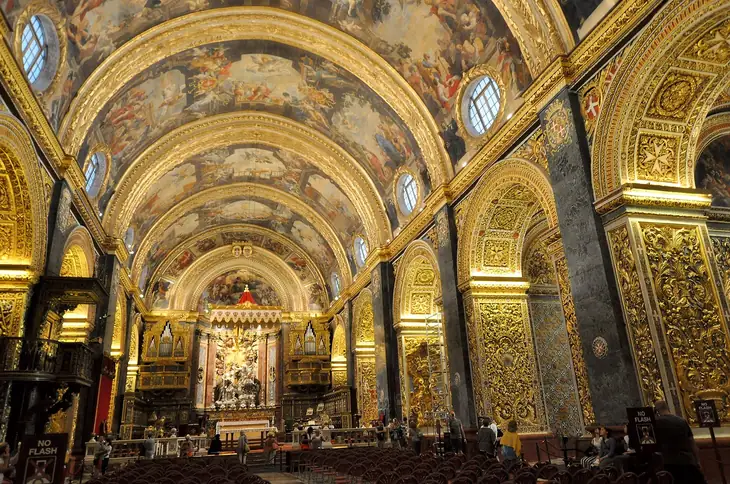
St. John's Co-Cathedral | Image by Herbert Frank on Flickr
This is the most famous and magnificent church in Valletta, and one of the finest examples of Baroque art in Europe.
It was built by the knights as their conventual church, and it contains many treasures, such as the Caravaggio paintings, the marble tombstones, and the elaborate chapels. The admission fee is €15 for adults, €12 for students and seniors, and free for children under the age of 12 when accompanied by an adult.
It’s recommended to allocate at least one to two hours to fully explore the cathedral, taking in the decorated interiors and admiring the artwork. Be advised that it is required to dress appropriately, as the cathedral still remains a functioning religious site. This means that revealing clothing and shorts are not permitted, and shoulders should be covered.
The Grand Master’s Palace

The Grandmaster's Palace | Image by M W from Pixabay
This is the official residence of the President of Malta, and the former seat of power of the Knights of St. John. It is a splendid building that features a state room, a throne room, a tapestry hall, and an armoury that contains over 5,000 pieces of armour, weapons, and firearms dating from the mediaeval period to the 20th century.
The Malta Experience and the Sacra Infermeria

Sacra Infermeria | Image by Knight doctor on Wikimedia Commons
If you need a respite from the heat typical of the Maltese summers, you may watch the show at The Malta Experience. This multimedia performance tells the dramatic story of the islands’ 7,000-year history and delves into their turbulent past. The feature portrays how the country has overcome tremendous challenges to become the nation that it is today. It is educational, interesting, and entertaining and is appropriate for the entire family.
Along with the Malta Experience, visitors can visit the Sacra Infermeria (also known as the Holy Infirmary). The Knights of St. John were founded as an order to care for sick, poor, and wounded pilgrims on their travels to the Holy Land, and the Sacra Infermeria digs into their healing methods. The building is no longer used as a hospital and is now used as a conference centre that has hosted numerous concerts and high-profile events.
Lascaris War Rooms

Lascaris War Rooms | Image by Juraj Jankovič on Flickr
The site is of great historical significance, as it offers insights into the strategic importance of Malta during World War II. It is a testament to the bravery and resilience of the Maltese people, who endured some of the most intense bombing raids in history during the siege of Malta.
Visitors to the Lascaris War Rooms can expect to see a range of exhibits and displays that bring the history of the site to life. One of the highlights of the museum is the opportunity to visit the original operations room, which has been restored to its wartime condition. Visitors can see the original maps, charts, and equipment used by the Allied Forces during the war, providing a unique insight into the workings of the war rooms.
The museum also features a range of audiovisual displays, including a film that tells the story of the siege of Malta and the role played by the War Rooms in the war effort.
Fort St. Elmo
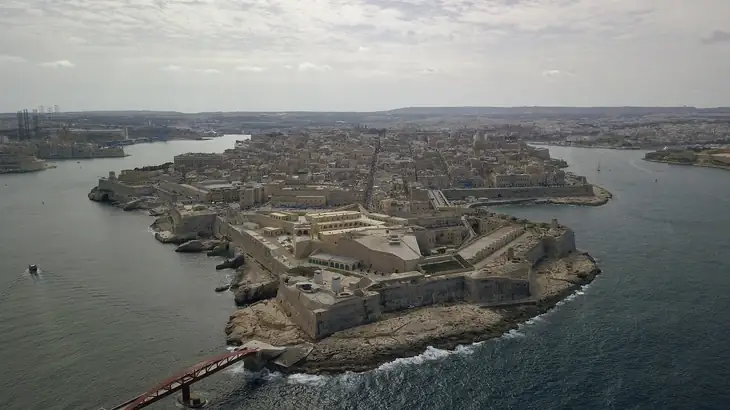
Valletta By Night | Image by Dion Hinchcliffe on Wikimedia Commons
Fort St. Elmo was built by the Knights in 1552 and played a crucial role in the Great Siege of Malta in 1565, as it served as the main defensive structure against the Ottoman invaders.
The fort is located at the tip of the peninsula, and visitors can walk the fortifications and attend events and reenactments that showcase the fort’s rich history. The fort also serves as a popular venue for concerts and other cultural events, making it a vibrant and exciting part of Maltese life.
The National War Museum

Spitfire Plane | Image by Alan Wilson on Flickr
Within Fort St. Elmo, you should not skip a visit to the National War Museum. This museum features exhibits on the islands military history, from prehistoric times to the present. It has a collection of armour, guns, and other military relics, as well as many images and records covering a wide range of eras.
The museum has extensive displays covering Malta’s involvement in World War II and complements the exhibits available at the Lascaris War Rooms.
The National Museum of Archaeology

Sleeping Lady at the National Museum of Archaeology | Image by Jean-Pierre Dalbéra on Flickr
This is the main museum of archaeology in Malta, and it displays a collection of artefacts from various prehistoric sites, such as the megalithic temples, the hypogeum, and the cart ruts. The admission fee is €5 for adults and €3.50 for students and seniors.
The Manoel Theatre
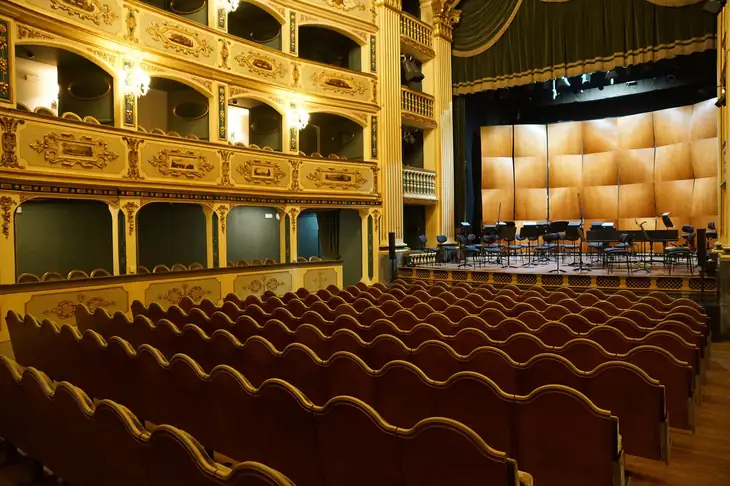
Manoel Theatre | Image by Otter on Wikimedia Commons
The Manoel Theatre is one of Europe’s oldest working theatres and is a beautiful example of Baroque architecture in the city. The theatre was commissioned by the Portuguese Grand Master António Manoel de Vilhena in 1721, from whom it derives its name. It quickly became a hub for cultural activities, and many famous artists have performed on the stage of the Manoel Theatre throughout the years, including the Italian composer Gioachino Rossini, the French writer Victor Hugo, and the legendary opera soprano Maria Callas.
The Malta Philharmonic Orchestra plays a regular concert season at the Manoel Theatre from October to June. Aside from classical music, the theatre hosts a variety of other events, such as plays, musicals, ballets, operas, and concerts.
For anyone interested in learning more about the architecture and history of this baroque gem in the centre of Valletta, a guided tour is also available. The Manoel Theatre certainly has something for everyone.
The Bell War Memorial
One of the most poignant and solemn monuments in Valletta is the Bell War Memorial, also known as the Siege Bell Memorial. It is located on the lower part of St. Christopher Bastion and was built in 1992 to commemorate the 50th anniversary of the awarding of the George Cross to Malta by King George VI in recognition of its bravery and resilience during World War II.
The Bell War Memorial is a simple but powerful monument that evokes a sense of reverence and gratitude for the heroes of World War II. It is also a testament to the courage and endurance of Malta, which earned it the nickname “the unsinkable aircraft carrier”. You can visit the Bell War Memorial for free and enjoy the stunning views of the Grand Harbour and the Three Cities from its location.
The Casa Rocca Piccola

Casa Rocca Piccola
Casa Rocca Piccola is the city’s only privately owned palace. The house was built in the 16th century and features an impressive collection of antique furniture, paintings, and tapestries that date back to the 17th and 18th centuries.
The collections also include unique artefacts such as an Egyptian mummy, a Maltese horse-drawn carriage, and the largest private collection of antique costumes on the island.
Casa Rocca Piccola is located on Republic Street, past St. George’s Square, and is open from Monday to Saturday between 10:00 a.m. and 5:00 p.m., with the last admission allowed at 4:00 p.m.
Admire the Scenery
Valletta is not only a city of history and culture but also a city with magnificent views of its surroundings, including spectacular views of the Grand Harbour and the Three Cities. Valletta also has several gardens, parks, and waterfronts that provide a green and tranquil oasis in the midst of the urban hustle and bustle.
Here are some top spots not to miss in Valletta:
The Upper Barrakka Gardens
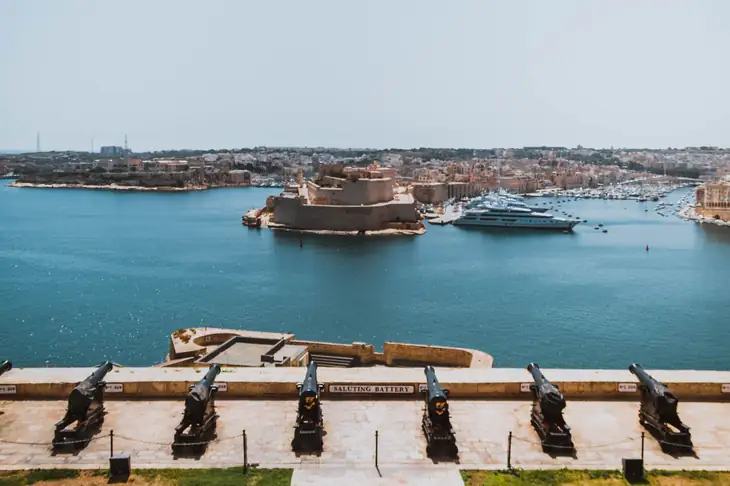
The Grand Harbour from the Upper Barrakka Gardens | Image by Kristina Paukshtite from Pexels
These are the most famous and visited gardens in Valletta, and they are located on the highest point of the city walls and offer panoramic views of the Grand Harbour and the Three Cities of Vittoriosa, Senglea, and Cospicua.
The Upper Barrakka Gardens were originally built in 1661 as a private garden for the Italian Knights of the Order of St. John. It was later converted into a public garden in 1824 by the British, who added several neoclassical features, such as the ornate monuments, fountains, and statues that still adorn the gardens today.
The gardens are also the site of the Saluting Battery, where you can witness the daily firing of the cannons at noon and 4 p.m. Admission to the gardens is free, but there is a small fee to enter the Saluting Battery.
The Lower Barrakka Gardens

Fountain and monument at the Lower Barrakka Gardens | Image by Bex Walton on Flickr
These are another set of gardens that are located on the lower part of the city walls, facing the entrance to the Grand Harbour. They offer a different perspective of the harbour and the Three Cities, as well as a monument dedicated to Alexander Ball, a British admiral who helped Malta during the French occupation.
The gardens are also a peaceful and romantic spot, with a temple-like structure, a pond, and a bridge.
The Hastings Gardens
Located on the west side of the city walls, overlooking Marsamxett Harbour, is Hastings Garden, which this time offers views of Sliema, Manoel Island, and Fort Manoel, as well as a memorial to Francis Rawdon-Hastings, a British governor who died in Malta. The gardens are also a relaxing place, where one can sit on one of the many benches and take in the atmosphere.
The Valletta Waterfront
This is a promenade that stretches along the Grand Harbour and is lined with historic buildings that were once warehouses for the Knights of St. John. In the early 2000s, the area was transformed into a commercial and leisure centre to complement the nearby cruise ship port, and today at the Valletta Waterfront, one can find a selection of restaurants, cafes, and bars, as well as a variety of shops and boutiques. The shops are housed in historic buildings, which add to the shopping and dining experience.
15. Attend a Festival or Event
Valletta is home to a variety of festivals and events throughout the year, from music festivals to cultural celebrations. Some of the most popular events include
- The Malta International Jazz Festival, usually held in July.
- The Valletta Baroque Festival is usually held in January.
- The Marsovin Summer Wine Festival is held in Hastings Gardens in July.
- The Delicata Wine Festival is another wine festival, this time set against the backdrop of the Upper Barrakka Gardens. The festival will be held in August.
- The Malta International Food Festival is a celebration of everything food-related and usually takes place in July.
- The Carnival, as you can imagine, is a colourful and festive celebration that features parades, floats, costumes, masks, dances, and parties. This is usually held in February or March.
- At the end of April, do not miss the International Fireworks Festival. A spectacular display of fireworks lights up the night sky over the Grand Harbour.
- The Notte Bianca is a night of culture and entertainment that sees the city’s museums, galleries, theatres, churches, and streets open to the public for free. This is held on the first Saturday of October.
- The Christmas Market is a festive market that sells traditional crafts, food, drinks, and gifts in St. George’s Square.
Go on a Food Tour
Valletta’s food scene is a melting pot of cultures and flavours, offering something for every palate. From traditional Maltese dishes to modern Mediterranean cuisine, there is no shortage of culinary delights in this city.
One of the best ways to experience Maltese cuisine is to take a food tour, sample some of the best dishes the local cuisine has to offer, like pastizzi, rabbit stew, and fish soup, and wash it down with a cold Cisk beer.
Navigate the Grand Harbour
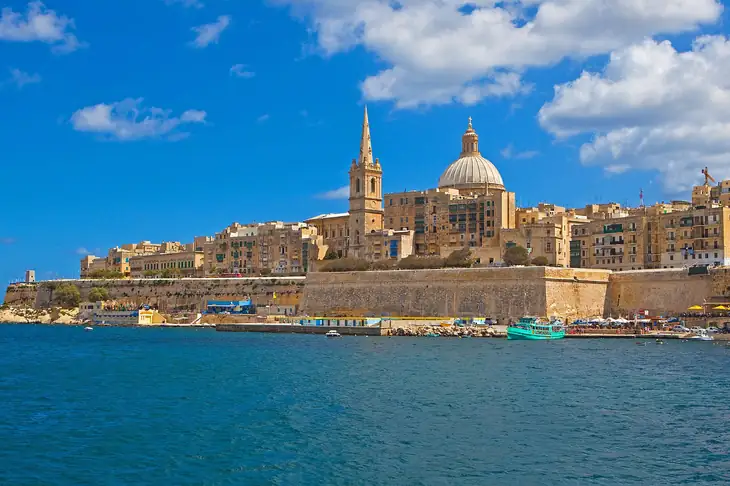
Valletta from the sea | Image by Bengt Nyman on Wikimedia Commons
The Grand Harbour Boat Tour is a 90-minute guided tour that departs from Sliema Ferries and takes you across the Marsamxett Harbour to Valletta before getting to the Grand Harbour, where you get to experience the stunning views of the city’s fortifications.
While cruising in the Grand Harbour, you also get to pass by the Three Cities of Vittoriosa, Senglea, and Cospicua.
Conclusion
Valletta is a city that has something for everyone. It is a city that combines history, culture, scenery, food, and entertainment in a unique and captivating way. It is a city that will surprise you, delight you, and inspire you.
Whether you’re looking for a relaxing getaway, cultural immersion, or a fun adventure, Valletta has it all. You can explore its museums, churches, and monuments; enjoy its gardens, parks, and waterfronts; taste its cuisine, street food, and nightlife; and indulge in its markets, shops, and theatres.
Valletta is a city you will never forget. It is a city that you will want to visit again and again. So, what are you waiting for? Book your trip to Valletta today and experience its best things to do for yourself!
Frequently Asked Questions
What are the opening hours of the main tourist attractions in Valletta?
The opening hours of the main tourist attractions in Valletta vary, but most are open from around 9 a.m. to 5 p.m. or 6 p.m. Some attractions may have extended hours during special occasions.
What is the history of Valletta, and what are some interesting facts about the city?
Valletta was founded in 1566 by the Knights of St. John, who built the city as a fortress to defend Malta from Ottoman attacks. The city has a rich history and is known for its Baroque architecture, which was largely rebuilt after the devastating Siege of Malta in 1565.
What is the best time of the year to visit Valletta?
The best time of the year to visit Valletta is during the shoulder seasons of spring and fall, when the weather is mild and there are fewer crowds. Summer can be hot and crowded, while winter can be rainy and chilly.
How do I get to Valletta?
Valletta is well connected with the public transport system, and it is the best way to get to and from the city cheaply and without worrying where to park your car.
What are the best bars in Valletta for a night out?
Some of the best bars in Valletta for a night out include StrEat Whisky & Bistro, Yard 32, and The Beer Cave.
Are there any beaches in Valletta?
Valletta does not have any beaches within its city limits, but it is possible to go down by the sea and even take a swim. Do keep in mind that as the ports are quite busy, the quality of the water might not be as good as in other places around the islands.







